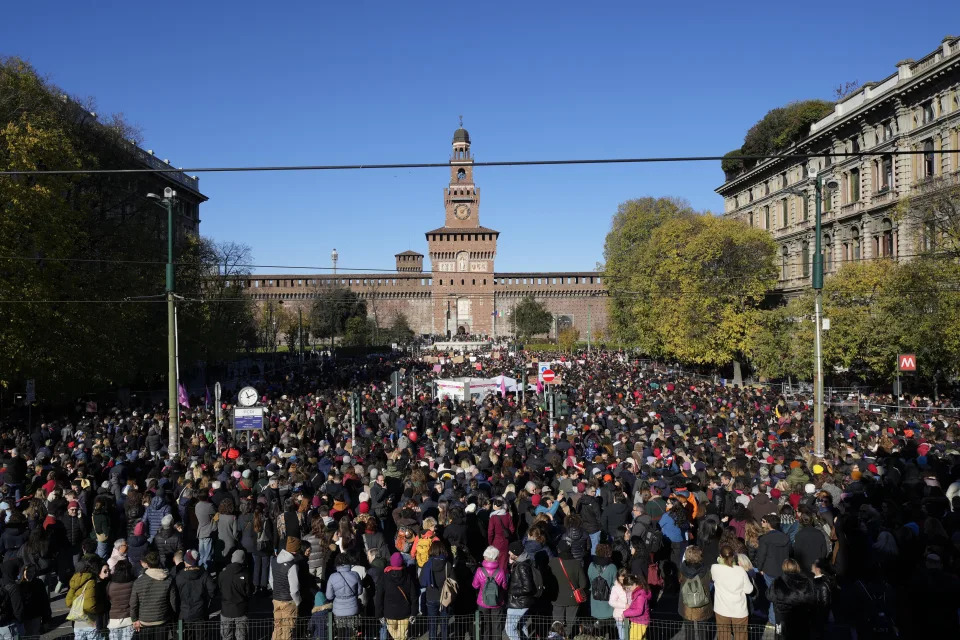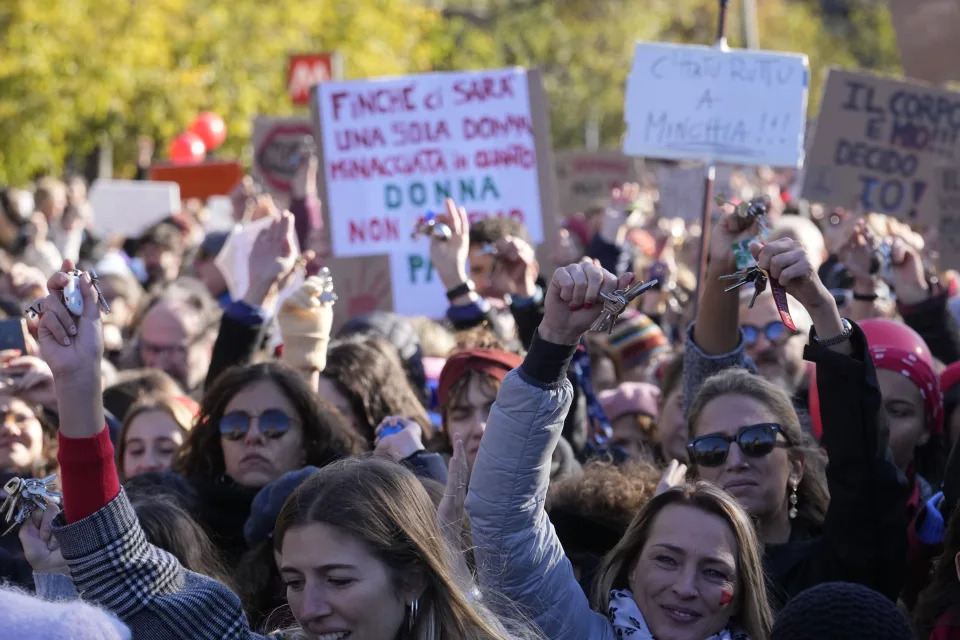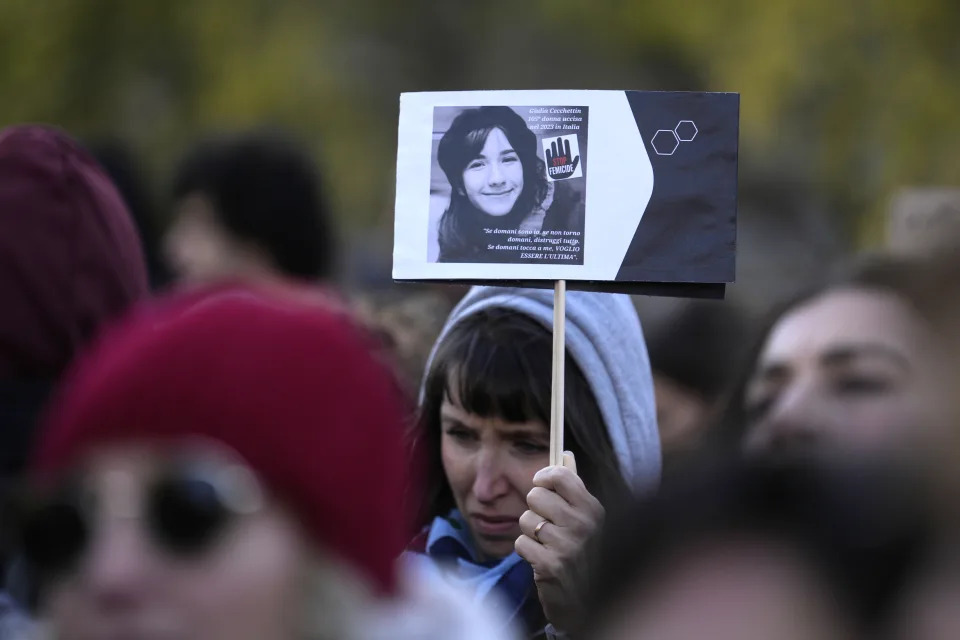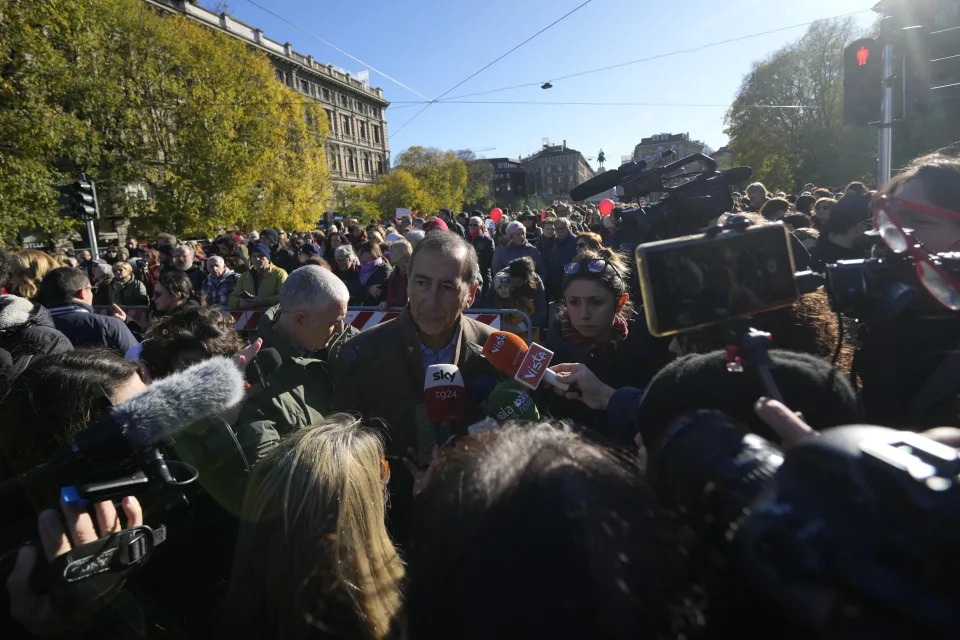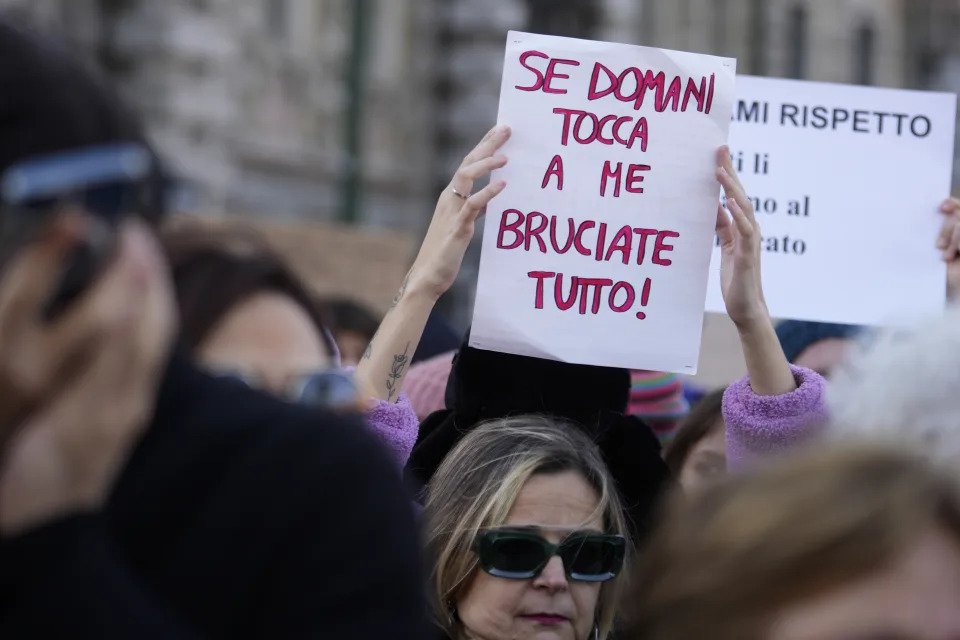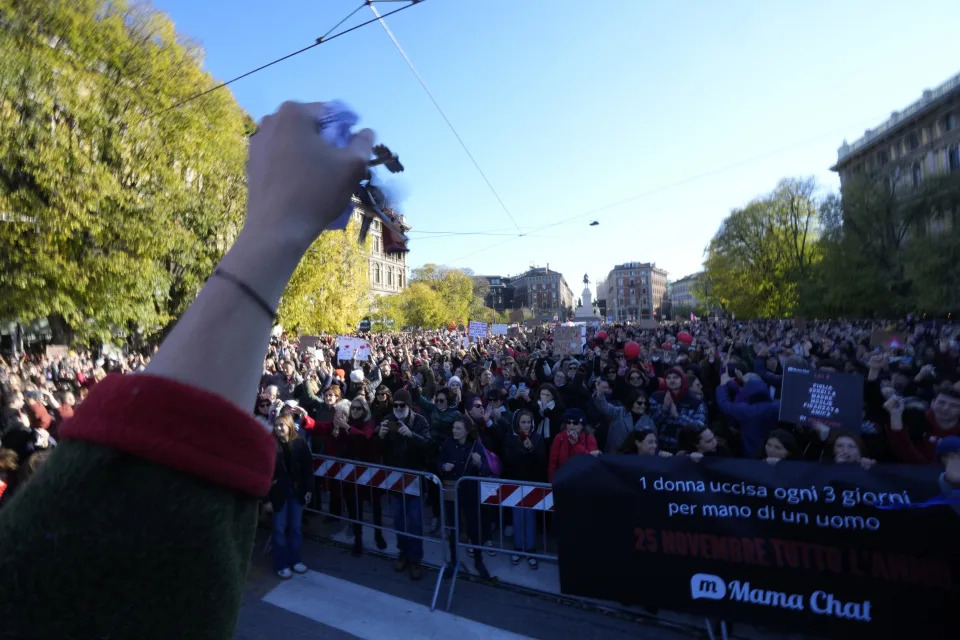Dispatch: The invisible killer haunting Laos 50 years after the Vietnam War
Sarah Newey
Sun, November 26, 2023

A technician in the fields of Laos prepares for a controlled explosion - Jack Taylor/Jack Taylor
At first glance, the scene is unremarkable: women in wide-brimmed hats are dotted across a rice paddy field nestled in the Laotian mountains, toiling under the relentless sun.
But instead of sickles, the women are carrying heavy metal detectors. Their buckets aren’t full of the staple crop, but scraps long buried in the ground. And at the edge of the plot, an ominous sign with red skulls screams “DANGER”.
At this site just outside the tiny village of Sop Hun, decontamination technicians are meticulously clearing up the legacy of a “secret war” so intense it earned Laos – then home to fewer than three million people – the grim status of the world’s most bombed nation per capita.
Between 1964 and 1973, as the US attempted to suppress communism in southeast Asia and cut off North Vietnam’s supply lines, American pilots unleashed more than two million tonnes of ordnance on this landlocked county in 580,000 attack sorties. On average, a planeload of bombs was dropped on Laos every eight minutes for almost a decade.
“The bombing was constant, people used to hide in caves underground to survive it,” says Khamsone Laomany, a war veteran who fought with the Americans. Lying on the floor beside him is his prosthetic – 53 years ago, the 78-year-old lost his right leg when he collided with an undetonated explosive as he was racing across the mountains to escape enemy fire.
Though brutal, incidents like this are expected during war – but in Laos, they never stopped. Since the Paris Peace Accords were signed 50 years ago at least 25,000 people, half of them children, have been killed or injured by unexploded bombs – including 63 in 2021 alone.
Many of these accidents have involved cluster munitions, a controversial weapon now banned in more than 120 countries yet – to Laos’ disbelief – deployed by both sides in Ukraine.
These bombs are indiscriminate; they break apart mid-air and scatter hundreds of smaller submunitions, known here as “bombies”, across a wide area. And while they’re meant to detonate on impact, the “dud rate” is high: up to 30 per cent of the 270 million dropped on Laos never exploded.
Instead they are littered, dormant but deadly, across huge areas of the country – remnants of a long-forgotten “shadow war” that ended five decades ago, but continues to stymie development and turn daily activities into a “game of Russian roulette”. Ukraine, people here say, should take note – Laos may offer a glimpse of the European nation’s future.
“We’re still affected by the conflict, people still have difficulty surviving after all this time,” says Ket, a section commander for the NGO Humanity and Inclusion (HI) in Phongsaly, the northernmost province, tucked between China and Vietnam.
“It used to make me angry, but now I think anger is not a positive thing,” adds the softly spoken 30-year-old, known only by her first name. “I would like to bring to the power countries and leaders: think of the impacts of war, especially the impacts of cluster munitions. I don’t want to see this happen again. Please, see Laos as a case study and stop.”

Instead of sickles, the women are carrying heavy metal detectors, scanning for UXO - Jack Taylor/Jack Taylor
Later that day, Ket slips into a bright blue blast suit and heads back out to set the fuses. After some six hours methodically combing the rice paddy field for “war trash”, the team of eight – including seven women – has uncovered two Blu 26 submunitions and a 20mm artillery bullet.
Now it’s time to blow them up.
“This is the most challenging part of my day,” says Ket. “If I did some small mistake, I might kill myself as well. It’s high risk for me, but I think it is part of my duty.”
Ket was compelled to join HI by personal experience; a neighbour was killed while farming at a plot near her home in the Hampheung province. Most here have similar stories. The team leader’s father was injured by UXO when she was four – he was lucky to escape with his eyesight – while the field medic’s friend had both her legs amputated after a blast.
“Of course my family worry that this job isn’t safe,” says Ket. “They ask, can’t you do something with less risk? But I tell them just living in Laos is a risk. I’m proud of my tasks here, that I am a person to help clear the UXOs and make this land safe. Accidents are too common.”
As Ket readies the ignition to detonate the munitions in-situ, the rest of the team fan out around a 300-metre radius to ensure the site is clear and warn the nearby school – children’s laughter fades away as pupils are told to return indoors. Soon, everything is set.
“Haa, sii, sam, song, nung,” a man shouts, counting down from five to one before deep, powerful blasts puncture the peace and reverberate around the valley with surprising force. Two plumes of thick smoke seep into the air above the spots the bombies once laid, hidden for decades under layers of soil.
It’s hard to know how many of these cluster munitions remain scattered across Laos, though estimates suggest just 10 per cent of some 80 million left when the war finished have been cleared. In 2019, the US Congressional Research Service said it could take at least another 100 years to decontaminate the country.
“The most horrific thing about this is the amount of bombs dropped … and the amount of war trash left, which people have to figure out a way to live with,” says Sera Koulabdara, the chief executive of the advocacy group Legacies of War. Now based in the US, her family left Laos when she was six, after a school friend lost her leg in an incident outside their home.
“It’s not just about the tragic fatalities and injuries, the land has been held hostage,” she adds. “Laos has a highly agricultural economy – but how do you expect the people to move forward, the economy to move forward, when dealing with this situation? Lots of the challenges [Laos] faces today come from the legacy of war, the chaos left behind.”

A controlled demolition of a munition found in a rice paddy - Jack Taylor/Jack Taylor
Clearing this land is a slow, repetitive process which got off to a slow start. Nationwide, bomb clearance organisations eventually launched operations from 1994; North Vietnam’s communist allies Pathet Lao took control after the war, and for two decades the nation was largely isolated from the wider world.
But in Phongsaly, it was only last year that work to rid the region of UXOs began, part of a government-led strategy to map contamination levels nationwide and redistribute resources.
Despite being a Pathet Lao stronghold, the province was not as heavily bombed as contested central or southern Laos. But Route Four – a winding road that snakes through forested mountain peaks – was a strategically important supply chain and access point for the North Vietnamese army, making it a regular target for the US Air Force.
“The northern provinces have been less invested in, just because of the scope of the contamination elsewhere and limited resources,” says Alexandra Letcher, a regional Armed Violence Reduction Specialist with HI, a French organisation which has launched awareness, rehabilitation and decontamination programmes across Phongsaly.
“But since we started here, we’ve found everything from huge aircraft bombs – their size is just really incredible – to bombies, which are most common.”
The lack of clearance operations until now has forced locals to live and work alongside these explosives for decades, even in places known to be contaminated.
Roughly 30 years ago, Bounsuly Soulinthong’s little brother Samly was one of three children who died in a blast while foraging for sweet potatoes on a hillside above Khoua – a small village on the Nam Ou river, an hour southwest of Sop Hun.
“The scraps hit my brother in the head. I saw him as they rushed him to get help, the side of his face was completely blackened from the explosion,” says Mr Soulinthong. Samly died not long after he reached the hospital; he was only seven years old.
“Everyone used to say we looked quite similar,” adds Mr Soulinthong. “I often think about what he’d look like now, and what his life might have been like – especially now my daughters are his age … I’ve told them they never can go to the hills near here.”
Many have adopted this approach, with development projects abandoned and farmland avoided due to UXOs. But this has not been an option for others, including Bouaphai Boutsady. The steep plot where Samly died is her only land, farming her only income.
For three decades she’s still grown vegetables and rubber trees there, developing ad hoc strategies in the hope of reducing her risk – all for a yearly income equivalent to £800.
“Of course the accident is in my mind still when I worked on my land, but what choice do I have? I just try to be careful – I dig softly and slowly and not too deep,” she says. “But I need to eat, I need to provide for my family.”
Somehow, and despite spotting several more UXOs, the 63-year-old has had no accidents. And now she never will: her half hectare plot was among the first to be cleared when HI arrived last year.
With contamination so widespread and the region’s steep peaks making work laborious and slow, the NGO works with the government to prioritise clearance sites – farmland, areas near schools or health clinics, and sites earmarked for development are top of the list.
“I no longer have fear when I go to my land,” says Ms Boutsady. “It is strange not to feel that emotion there anymore. It was like anything could happen to anyone at any time – the bombies had a huge impact on every part of our lives.
“I don’t know if the people who dropped them realised the impact would last to the next generation? But they should know now. People in power, people who create war, I would encourage them to look and see that bombies kill people, kill villages, for a long time.”

A huge number of cluster munitions remain scattered across Laos - Jack Taylor/Jack Taylor
This sentiment is widespread across Laos; almost everyone The Telegraph spoke to said they struggle to comprehend why cluster munitions, which have caused so much harm here for so long, are still being deployed elsewhere.
In recent decades, Laos has been increasingly vocal about this issue on the international stage, and played a major role in the creation of the Convention on Cluster Munitions in 2008.
More than 120 countries have since joined this international treaty, including the UK, but there are notable absences – including Russia, Ukraine and the US. As the fighting continues in Europe, all three have been involved in their use.
“As the world’s largest victim of cluster munitions… [Laos] expresses its profound concern over the announcement and possible use of cluster munitions,” the foreign ministry said in July, when reports that America would send several shipments to Ukraine first emerged.
“[Laos] calls upon any state or actor to refrain from all use, production, transfer and stockpiling of cluster munitions as prescribed in the Convention on Cluster Munitions, so that no one in the world would be victimised by such [a] heinous weapon.”
The US has since sent three shipments to Ukraine, with the White House arguing that while it recognises the risks for civilians, the threat to Ukrainian people if Russia gains more territory is “intolerable”.
“I’m really trying to inspire my country, the USA, to adopt a more humane policy,” says Ms Koulabdara. “The reason we’re so against it is obvious, we need to learn from history, learn from our last use in Laos.
“But we also know that these weapons will eventually harm Ukrainian men women and children, potentially for decades … Because of their indiscriminate nature, these weapons should be treated in the same way as chemical weapons.”
For Mary Wareham, advocacy director of the Arms Division at Human Rights Watch, the US transfer demonstrates the importance of destroying stockpiles – “if countries have them, they’ll use them”. And because many of the cluster munitions being sent are relatively old, it’s not clear what the “dud rate” will be.
“The US transfer does also bring into question the emerging norm, stigmatising any use by any actor under any circumstance,” she says. “The US is basically saying this is a special case and nothing else will work … that chips away at the norm everybody’s been trying so hard to put in place over the last 15 years.”

The field operators taking their lunch break - Jack Taylor/Jack Taylor
Back in Sop Hun, three boys kick a ball around a dusty clearing in front of the village hall. As darkness descends the boys, sporting Manchester City and Paris Saint Germain football shirts, pause to talk to The Telegraph. Have they ever come across a bombie?
“I saw one by the river and picked it up,” says 12-year-old Anaithap, gesturing down the slope behind the concrete building. “When I told my parents they were so angry, they kept saying I was so lucky to be alive still. But I didn’t know it was a UXO, it looked like a pétanque ball.”
Later, as the decontamination team shares dinner and Beer Lao at a long table in the village hall – their makeshift home while they work in the nearby fields – they explain this confusion is common.
Pétanque, a game similar to boules, has been popular here since the French introduced it in the former colony. But children often see the round, metal cluster munitions and mistake them for lost pétanque balls.
“Many children pick up bombies thinking they’re toys, we hear this a lot,” says Ket. It’s why awareness and education programmes are as important as the land clearance operations, she adds.
But there are concerns that some of these projects are under threat; in recent few months, HI has had to downsize its teams in Hampheung due to financial constraints.
“It’s been very, very difficult [to raise funds],” said Ms Letcher. “It’s tough when you come to the end of a project and there’s no visibility on other funding, we have no option but to scale down operations. Hopefully, hopefully, we can find something soon.”
HI is the only organisation operating in Laos that does not currently receive US funding, which has been steadily increasing since Barack Obama became the first sitting president to visit the country in 2016.
Still, aid to clean up the UXOs pales in comparison to the cost of the bombardment – in 2023 dollars, the US spent $16 million every day bombing Laos for nine years. According to Legacies of War, funding to decontaminate now stands at just $45 million per year.
“The bombs that were dropped on Laos … are American bombs,” says Ms Koulabdara. “So from my perspective, this should be a top priority and funding should be guaranteed until we get the job done.”
But as the decontamination team refill their glasses and tuck into plates of sticky rice and larb salad, they admit they’re unsure if Laos can ever truly be free.
“I think we have to try for the next generation, but I don’t know, there are so many…” says Ket, shaking her head instead of finishing the sentence. “It’s just a very big task.”




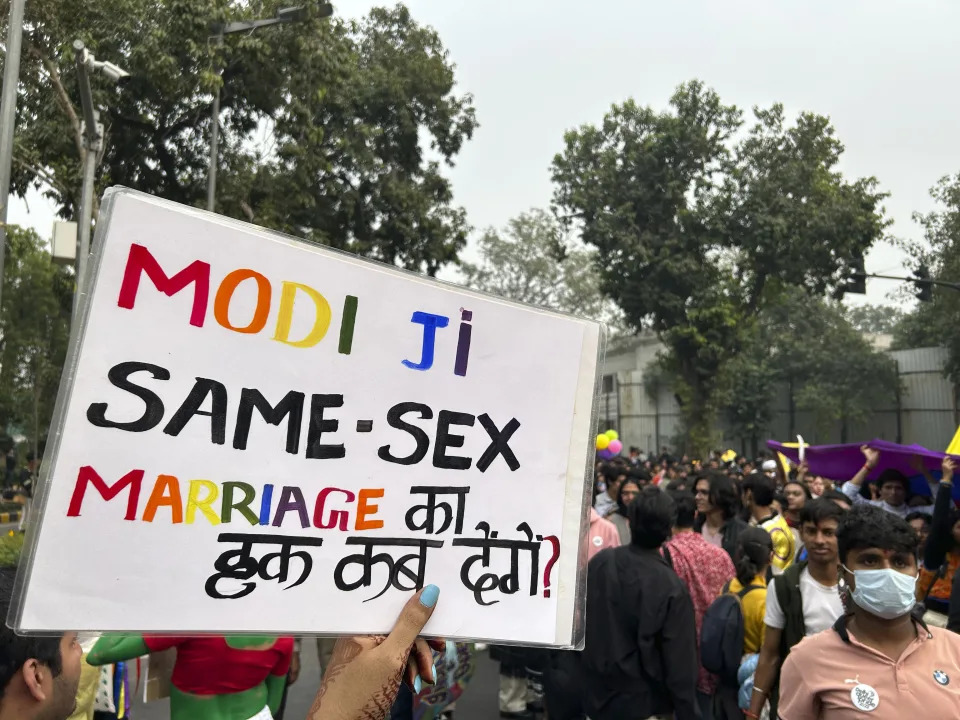












 A woman holds a placard that reads "Christmas arrives within the murder of 15 women", in reference to the rate of femicides in France, during a demonstration on the International day for the Elimination of Violence Against Women in Paris on November 25, 2023.
A woman holds a placard that reads "Christmas arrives within the murder of 15 women", in reference to the rate of femicides in France, during a demonstration on the International day for the Elimination of Violence Against Women in Paris on November 25, 2023. 

